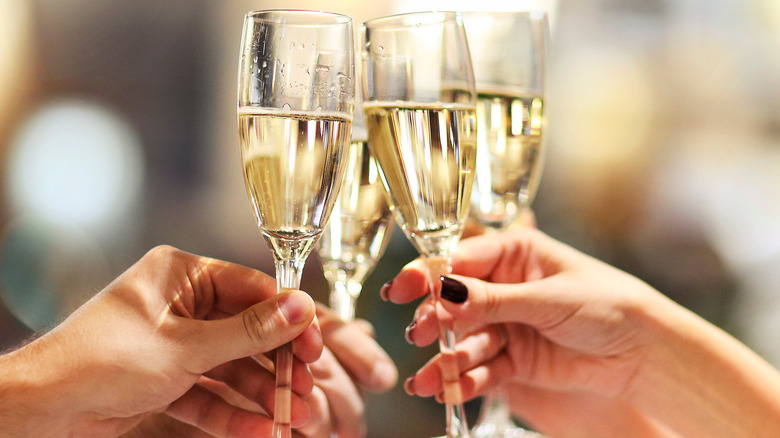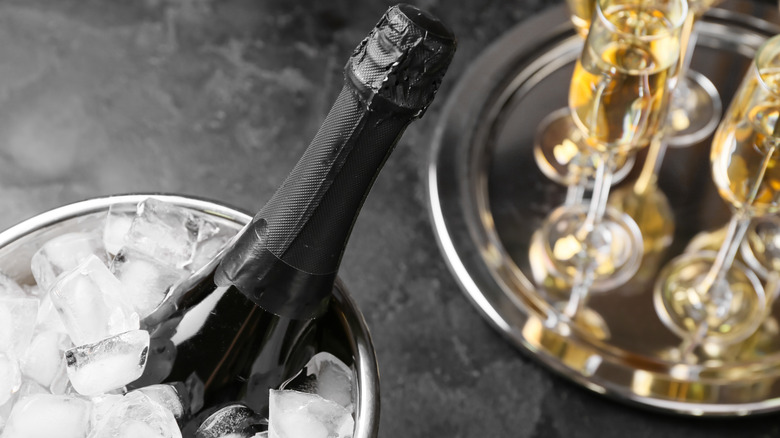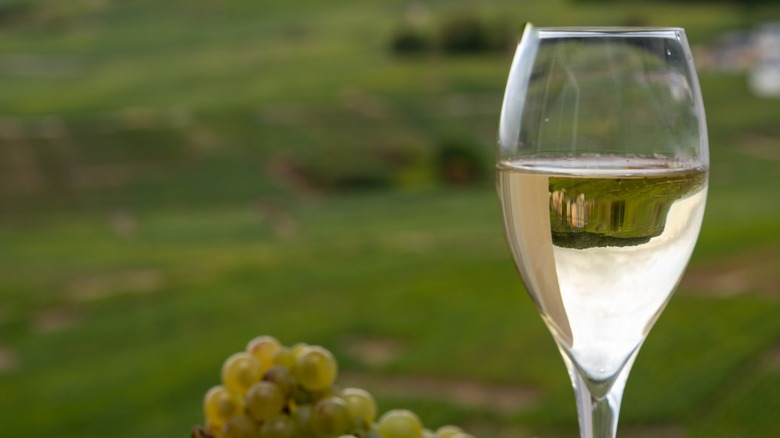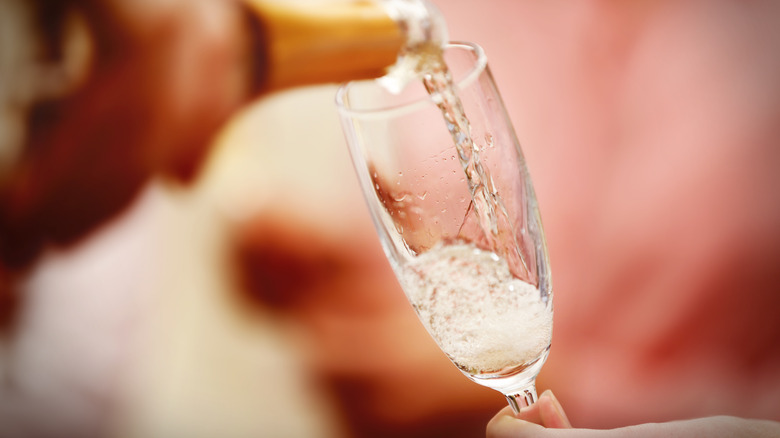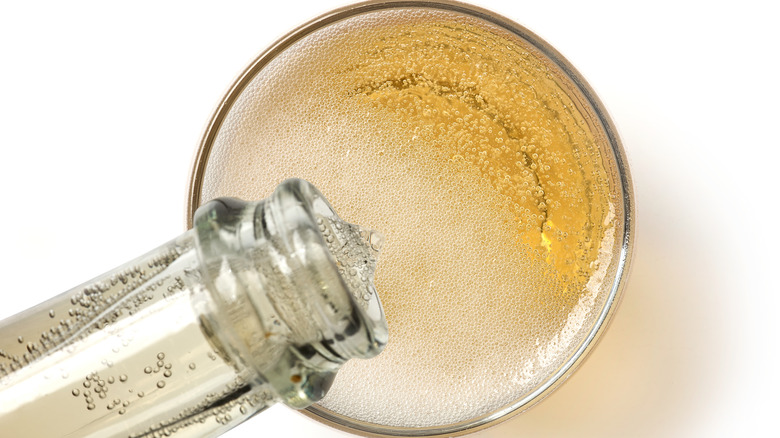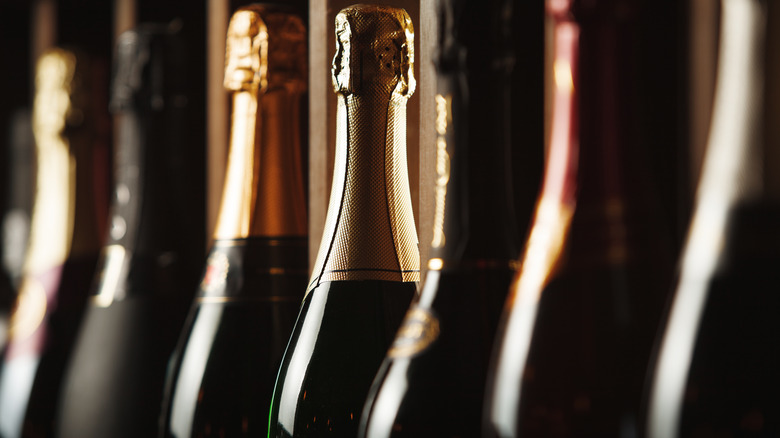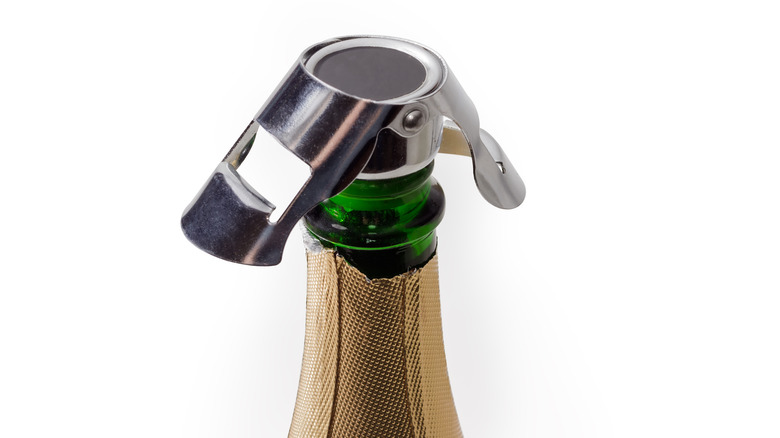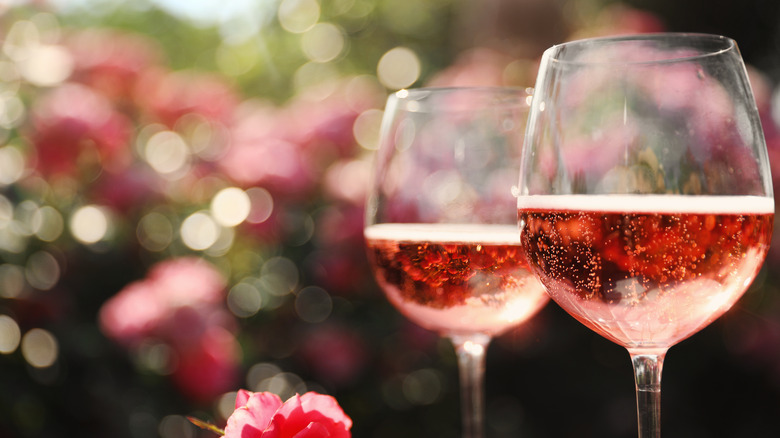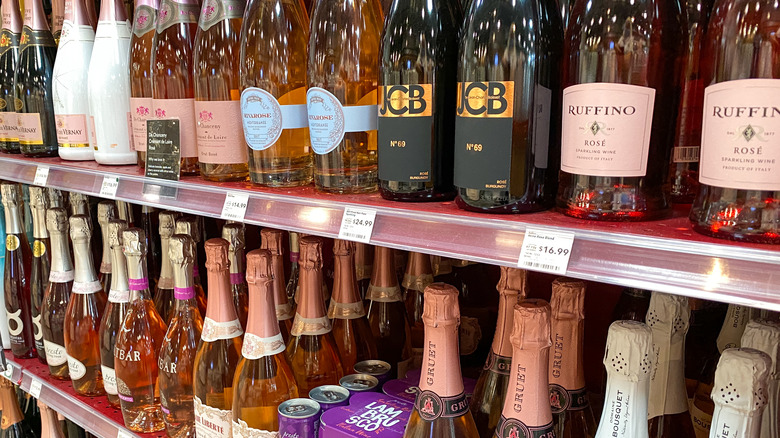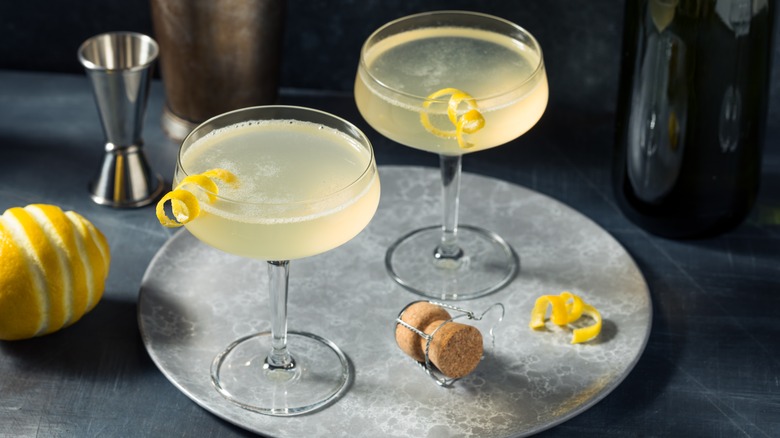Avoid These Mistakes When Drinking Champagne
Champagne — just saying the word fills the mind with effervescent joy. Ringing toasts, clinking glasses, and foaming bubbles are near-universal symbols of celebration and merriment, marking holidays, weddings, birthdays, and graduations. Popping open a bottle of bubbly can turn an ordinary day into a memorable occasion, and the world seems to be celebrating more and more after a tough pandemic: Champagne sales surged across the globe in 2021 (per CNN). But how much of it is needlessly going to waste?
From handling the pesky pressurized cork to getting the tumultuous liquid into your glass, a lot can go wrong when serving this buoyant beverage, especially once you've loosened its cage. So the next time you're blessed with a bottle of prized Champagne, set yourself up for success by avoiding these missteps and pouring like a pro. With these tips, you'll be able to savor every festive, fizzy drop and forget about your Champagne problems.
Opening the bottle improperly
Opening a bottle of Champagne can feel as daunting as bypassing security to break into a bank vault. But instead of alarms, lasers, and armed guards, you have a strong cork, a wire cage, and a thick layer of foil to contend with — that's because the carbon dioxide that creates the wine's signature sparkle also means that the wine is bottled under extreme pressure (up to 90 pounds per square inch, per Wine Spectator).
While shaking up bottles and showering your teammates with geysers of Champagne after a Game 7 victory looks like fun, it's not a safe move, and will only end in wasted wine and potentially even injury, as the Union des Maisons de Champagne (UMC) explains. If proper technique isn't used, a cork can shoot from its bottle and travel at over 40 feet per second, so it's best to use caution and avoid this flying hazard.
The ideal way to open a bottle of Champagne, according to Wine Folly, is to hold it at a 45-degree angle (making sure the cork is not pointing at anyone or at anything fragile), carefully remove the foil, and then unbind the metal cage underneath while keeping a hold on it and the cork at all times. Slowly twist the body of the bottle, not the cork or the neck, until the pressure is released. A flawlessly opened bottle will barely emit a sound.
Make sure the bottle is properly chilled, too — Wine Enthusiast explains that a warmer bottle is far more likely to foam up and spill out as it's opened.
Drinking Champagne too cold or too warm
Inside every drop of Champagne is a spectrum of flavors and aromas just waiting to express themselves. But too often, they never get the chance. Champagne needs just the right conditions to be thoroughly enjoyed, and one of the main variations that can affect the flavor is temperature. Like any other wine, if it's too cold it will come across as muted and neutral, and your chilled palate will have a harder time picking up nuanced tastes; if it's too warm, it can seem flat and heavy in your mouth — and most of us are getting this wrong, says the Washington Post.
There's no one perfect temperature at which to serve Champagne — it all depends on the style of wine, pairings, and personal preference, as Roederer V.P. Jean-Baptiste Lecaillon explained to Wine Enthusiast. However, experts generally agree that Champagne should be poured somewhere around the range of 40 to 50 degrees Fahrenheit, and this can be achieved using any number of methods, per Wine Enthusiast, including insulated sleeves, ice water and salt, and the good old refrigerator (if you've planned ahead). Bear in mind that once the wine is in a glass it can warm up quickly, so keep the bottle submerged in ice water or refrigerated when it's not being poured to keep it in the right range (via UMC).
Using the wrong glass
This may come as a surprise to many, but the flute — so iconic it has its own emoji — is one of the worst glasses from which to drink Champagne. Before you take a regretful tour down memory lane ruing all of your life's subpar toasts, don't beat yourself up too much. The flute's one advantage is that its tall, narrow shape is great at keeping your bubbly — well, bubbly (via Decanter). But a study by Master of Wine Vicky Burt concluded that sparkling wine consumed from flutes expressed the least aromatic intensity compared to other common glass types. Shallow saucer-shaped coupes, another popular style, are also suboptimal for Champagne, as the wide surface area causes the wine's sparkle to quickly fizzle, as Decanter notes.
Burt's research explains that a great choice for Champagne is the tulip glass: it's narrow at the bottom like a flute, in order to encourage lively sparkles, and wider toward the lip to allow the aromas to be appreciated. A basic white wine glass is a solid option as well, and although the broader bowl will not keep the bubbles active for as long as the narrower tulip, the wide mouth is the best way to take full advantage of the wine's bouquet.
Pouring and drinking too quickly
Champagne is best enjoyed when it's savored, not rushed, especially if you're trying to keep your wits about you — a controlled study showed that bubbly gets you drunk faster than still wine. And slower consumption not only allows you to appreciate each sip, it can also help to avoid a hangover, says Healthline. This principle should be applied not just to consuming the radiant beverage, but to pouring it, too.
Once the bottle is open and you're ready to get the wine flowing, speed is your enemy. The faster you pour, the faster the foam forms atop the surface of the wine, and too much foam can get out of control quickly, causing the Champagne to gush out of the glass like lava erupting from a volcano. Avoid this natural disaster by letting the open bottle settle for a few moments, then pouring the wine gently and steadily, making several small pours into each glass if necessary. The goal, according to Comité Champagne, is to avoid too much froth — the bubbles are there to enhance the wine's other qualities, not overpower them.
To tilt or not to tilt? Gérard Liger-Belair, a French physicist who's done extensive studies on the science of Champagne and effervescence, found that you'll get more bubbles for your buck with an angled pour along the side of your glass than you will going straight down the middle (via the BBC).
Pouring too much
When pouring Champagne, it's certainly tempting to fill your glass up to the brim, especially when splitting a bottle with friends. You want to make sure you get your fair share of the stuff, after all. But it turns out that filling a glass too high isn't the best idea if you want to fully enjoy all of the elements of the beverage.
The official Comité Champagne says that two-thirds of the way full is the level you want to shoot for — any more than that and there won't be enough space for you to immerse your nose in the Champagne's cloud of intoxicating perfume. And if you're a wine swirler, you're going to need that room at the top of the glass for the bubbly to swish around, letting you appreciate all its components, including fragrant aroma compounds (via Wine Enthusiast).
Too much wine in the glass can adversely affect its temperature, as well, leaving the wine at the bottom warm by the time you get to it (unless you plan to chug it, which is not recommended). So remember to keep your pours petite.
Storing Champagne bottles incorrectly
If you're a pillar of self-discipline and plan to store unopened bottles of Champagne in your home for a long period of time, it's important to understand the basics of wine preservation — otherwise, you may find that when the time comes to crack open a bottle, its bubbles and flavors may disappoint rather than delight.
How can you avoid this grim scenario? First, get to know wine's "greatest enemy,": oxygen (via JancisRobinson.com). Your mission when storing wine long-term is to keep it away from air, and that means ensuring the cork maintains its integrity. Keep the temperature and humidity moderate and steady, and lay the bottle on its side or at an angle to keep the cork from losing its airtight seal. That's a danger to any wine, but a particular hazard for sparklers, as their pressure will escape and leave the wine inside flat.
Be especially careful with Champagne in your refrigerator, even if it's unopened, as the arid environment inside can lead to the same terrible fate — after a few days, you run the risk of a dry cork letting in oxygen, according to winemaker Marie-Christine Osselin (via HuffPost). That oxygen can also bring with it unwanted odors, according to UMC, and the last thing anyone wants is a flat glass of Champagne that tastes like cold cuts and leftover pizza. So if there's a bottle of bubbly chilling in your fridge right now, you've got a great excuse to open it.
Not using the proper closure when resealing the bottle
In the nearly unimaginable event that a bottle of Champagne isn't drained in one sitting, you might think the leftover wine is doomed to lose its sparkle. And unless precautions are taken, you're right! From the second a sparkling wine is opened, it begins to lose its pressure and freshness. There are few things bleaker than a half-empty bottle of stale, flat Champagne that's gone to waste.
Regular sparkling wine drinkers should keep a few specialized Champagne stoppers around. Unlike a reused cork or a regular wine stopper, these items have arms or hinges that work with rubber rings to create an airtight seal that ensures oxygen stays out and bubbles stay in, keeping the fizz alive for a few more days.
Oh, and if you've heard that inserting a silver spoon into an open bottle keeps it from going flat, forget it. As reported by The Conversation, a study published in Le Vigneron Champenois proved that there's no scientific basis for this myth, so you're sure to only end up fizz-less and disappointed if you try it yourself.
Saving Champagne for only special occasions
While Champagne is the go-to bottle for special nights and holiday festivities, it's not usually the first drink that comes to mind for a stay-in movie night with takeout noodles or a casual post-work Monday happy hour. Champagne's reputation as one of the world's finest beverages (along with its price tag) may hold you back from having a glass whenever the mood strikes, but why deprive yourself?
Drinking Champagne regularly may bring more advantages to your life than just sensory enjoyment. Studies by the University of Reading have shown that moderate weekly consumption of Champagne can lead to improvements in memory and certain vascular functions, so add a little bubbly alongside your cardio and sudoku routines for an extra brain and body boost.
Champagne also happens to be one of the most versatile categories of wine to pair with food — there's almost no cuisine on the planet that wouldn't be complemented by a glass of the good stuff, and it can be served with every course in a meal, from opening toast to dessert, says the UMC. Oysters and caviar are classic accompaniments, but you might be surprised by how well Champagne enhances everyday dishes. Its naturally high acidity cuts like a laser beam through rich, fatty, and salty foods, as expert Jen Pelka told Vinepair — give it a try with buttery popcorn, fried chicken, or potato chips.
Avoiding pink bubbles
Pink bubbles can face an uphill battle on a wine list or store shelf. For years rosé wines of all kinds were unfairly stereotyped as frivolous and fruity because of their color, thanks in no small part to the California White Zin boom: "there was a perception in American culture that rosé was a sweet, low-alcohol wine," wine director Thomas Pastuszak told GQ. But sparkling rosé sales have been rising rapidly since 2015, reports alcohol delivery service Drizly's BevAlc Insights, and show no signs of slowing down. Vivino founder Heini Zachariassen told Decanter that 2022 looks like "a big year for sparkling rosé," so if you have yet to take the pink bubbly plunge, there's no time like the present.
Just like its white counterpart, rosé Champagne comes in many styles and sweetness levels, and the vast majority are dry. Pink bubbles are notoriously food friendly, with a variety out there to match just about any dish — from a fresh, crisp sparkler that's great with seafood, to a burlier, richer rosé that you can even pair with beef, according to Wine Enthusiast. So the next time you're looking for a sparkler to open for a special dinner or even just a casual hang, don't be afraid to think pink. It's not just for Valentine's Day anymore.
Missing out on the joys of grower Champagnes
When most of us think about Champagne, it's the major brands that come to mind — the Moëts and Veuve Clicquots of the world, with their splashy ads and celebrity fans. The handful of juggernauts who rule the global market are popular for a reason: they produce an abundance of products that dominate shops and restaurants, and their wines are made to be consistent from bottle to bottle, year to year. When you buy their Champagnes, you know exactly what you're getting — not necessarily a bad thing, says the New York Times.
But if that's the extent of your Champagne journey, you're missing out on some of the most exciting sparklers that come out of the region. While they make up a tiny percentage of Champagnes that we see in the U.S. (5% of imports, according to Wine Folly), wines known as grower Champagnes are well worth seeking out, especially if you have an adventurous palate.
What makes them unique? Wine Folly explains that most wines from the big houses are made from grapes purchased from growers all over the Champagne region, and the winery's goal is to maintain the same flavor profile with each batch. Grower Champagnes, by contrast, are wines made by the grape farmers themselves, intended to express their singular terroir and individual vintage — think of them as artisanal Champagnes: hand-crafted and one-of-a-kind.
Look for the letters RM on the label — it means récoltant-manipulant, signifying a grower-produced Champagne.
Confusing it with other sparkling wines
Champagne is the reigning champion of sparkling wines when it comes to prominence, prestige, and price, but there are plenty of other competitors around the world gunning for that crown, and it's helpful to know the difference so you don't feel lost while you're shopping for just the right bottle.
Sparkling wines are divided into categories by their production methods — basically, the different ways they get their bubbles, as explained by Wine Enthusiast. The most time-consuming and costly of these is known as the Traditional Method, which involves a complex series of steps and leads to the finest and most age-worthy sparkling wines (as opposed to less complicated methods that produce simpler wines like Prosecco). This top tier is, of course, Champagne's category, but it's not the only wine made this way: Italy's Franciacorta, Spain's Cava, South Africa's Cap Classique, the sparkling wines of England, and those from other parts of France (known as Crémant) all utilize this method, and thus can look and taste quite similar to real Champagne.
There's certainly nothing wrong with enjoying these wines, and many of them will put a much smaller dent in your wallet while offering a similar experience. You might even think they taste better, like the wine experts who gave English bubbly the top prize when tasted blind next to Champagne, as The Drinks Business reported. But when you have your heart set on the real thing, there really is no substitute for Champagne.
Not using Champagne in cocktails
There's nothing wrong with being a purist and only drinking Champagne in its natural form, but the iconic French bubbly also makes a fantastic addition to cocktails. While you probably don't want to open the priciest vintage Champagne to throw in your mimosa, the complex flavors and unmistakable fine bubbles of true Champagne can elevate any drink recipe that calls for sparkling wine.
The classic gin-based French 75 is a great place to start, along with its variations like this American 25 that swaps out the gin for apple brandy and Scotch. And there may be no better way to start your day than with an elegant Sparkling Pear Cocktail, the perfect drink to serve at a brunch. Champagne cocktails can also cure what ails you if you had a few too many the night before, like this restorative St. Bernard, with bitters and bubbles to help settle your stomach. Don't be afraid to get creative — you can even make Champagne ice cubes to add a classy chill to your drinks.
